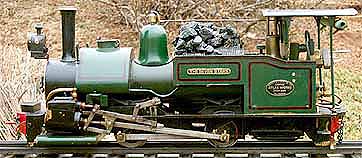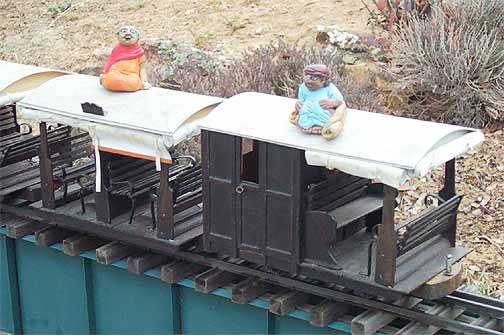
Back to Loco of the Month homepage
Back to Sidestreet Bannerworks
.
February 2005
Archangel Darjeeling Class B 0-4-0T
by Marc Horovitz

The Darjeeling Himalayan Railway (DHR) opened in July of 1881, traveling from Siliguri to Darjeeling, which lies about 375 miles north of Calcutta. The railway was built to haul tea and tourists, and was a great success from its opening day. However, the route that it traveled was tortuous. With grades as steep as 6% and curves as sharp as sharp as 57' radius, the 2'-gauge line traverses some of the most spectacular scenery anywhere.
The first locomotives on the line were small 0-4-0s, which proved unequal to the demands of the line. The next engines, the Class B models, developed by Sharp Stewart of Manchester, proved to be just what was required. It is these Class B tank engines that are still in use today, though in sadly diminished numbers. There were 34 Class Bs built between 1889 and 1927. Today, only a dozen or so remain functional.
Sharp Stewart’s Class B engine is one of the most distinctive and easily recognizable locos ever made, with its coal bunker atop the boiler in front of the cab and the unusual collar tank forward of the bunker. Two heavy rerailing poles were standard equipment on these engines. Surprisingly, each engine had a standard crew of five men! There was the driver and the fireman; there was a fellow who sat atop the coal pile, whose job it was to push the coal towards the fireman; and then there were two men who sat on the front end beam, whose job it was to drop sand (by hand) onto the rails when ascending, to maintain traction.
If you would like to know more about the DHR and its equipment, there are several good web sites. Here's one.
The model
In the small-scale-steam modeling world, the Darjeeling Class B locomotives have most recently been made famous by Roundhouse Engineering's beautiful model. But Roundhouse was not the only company to make this engine in 16mm scale. Stewart Browne of Archangel made a few -- perhaps 7 or 8 over the years.
The example I have is an impressive model that truly captures the essence of the prototype. It is painted green, an earlier livery than the current blue, and is nicely lined out in black and red. The steam dome lifts off to reveal a filler plug. Under the dummy water hatch is a Goodall-type filler valve. A displacement lubricator sits on the left side of the boiler, in front of the cab. The gas-control valve occupies the same position on the other side.
The backhead features a throttle, a water glass (with a blowdown valve), and a pressure gauge. A reversing quadrant stands next to the right-hand cab wall. Prototype builder’s plates adorn the exterior cab sides, while Archangel’s own plate sits above the boiler inside.
The inclined cylinders are controlled by Walschaert’s valve gear. All the motion work is steel, and is well made. All the important details are present, save the rerailing poles. This engine was formerly owned by Rob Bennett, of Home & Colonial fame. When I received it, it was in good mechanical shape, but had seen a good deal of use. The back rail of the cab was gone, which I replaced (it still needs paint) and some of the coal has disappeared along the way (which I have not yet replaced). The coal is glued to a removable screen that covers the twin gas tanks. These tanks can be filled with or without removing the screen. The front wheel-guard rail, below the coupler, is also missing -- I shall have to make another. The smokebox front clips into place and is easily removable.
The engine arrived with a complete train of half a dozen of Rob Bennett’s cars and even a couple of Maureen Watkins’ delightful figures. The four-wheel rolling stock includes three open coaches, a guard’s van, and two freight wagons, all of an older style.
The run
Today's run was in 30-degree temperatures, with high humidity and heavy, overcast skies -- in short, an ideal day for a steamup. To prepare the engine, I oiled it all round, emptied and refilled the lubricator, then filled the boiler with distilled water through the filler plug under the dome. I filled the gas tanks, the left one first, then the right. I lit the fire under the smokebox and it caught instantly. Cold weather is generally not good for gas-fired engines. However, with the tanks situated near the boiler, this proved not to be a problem.
In six or seven minutes the pressure had climbed to 60 psi and the safety let go. I opened the throttle and, after the usual gurglings while the cylinders cleared, the engine moved quietly away. Being a high-pressure engine, it is capable of tremendous speed. However, it is easy to throttle down to a nice, slow pace, even running light.
I ran it around once to warm it up, then coupled on its train. Control is really excellent, and I was able to slowly start it and to keep it throttled down to a sedate, realistic pace, with clouds of steam billowing into the cold winter air. Wonderful!
The run lasted perhaps 25 minutes, when the gas was exhausted. I could have prolonged the run if I had topped up the gas when pressure had come up. I uncoupled the train and the engine crept around for one last lap, virtually running on empty. When at last it would go no further, I opened the blowdown valve and drained the boiler.
This was a superb run on an ideal day with a truly fine locomotive. . .just about as good as it gets.
.
|
|
|
| Builder | Archangel Models (Great Britain) |
| Date built | Circa 1998 |
| Gauge | 32mm |
| Scale | 16mm = 1'0" |
| Boiler | Single flue |
| Fittings | Safety valve, throttle, water glass and blowdown, pressure gauge, Goodall-type filler valve |
| Fuel | Butane |
| Blow-off pressure | 60 psi |
| Cylinders | Two, double acting, D-valve |
| Reversing gear | True Walschaert’s |
| Lubricator | Displacement |
| Weight | 6-1/2 lb. |
| Dimensions | Length, 13-1/8"; width, 4-1/8"; height, 5-5/8" |

The train as received. Rolling stock is by Rob Bennett (Home & Colonial), figures are by Maureen Watkins.
.


The Darjeeling Class B engines are unique. Their outline is unmistakable. It is a favorite of narrow-gauge enthusiasts worldwide.
.

The model has a dummy headlight. The smokebox front comes out with a tug, allowing access to the plumbing inside the smokebox. The distinctive brass pipes on either side of the smokebox, on the prototype communicated between the collar tank and the flat tank carried under the cylinders (dummies on the model). The brackets on either side of the collar tank held large rerailing poles (missing here).
.



The diminishing coal pile is actually glued to a screen. The whole can be removed, although the tanks can be refilled without removal. Despite all the insulation, the dual gas tanks still heat up.
.
A neat backhead adorns the engine. Throttle in the center; water glass with blowdown on the left; builder's plate above the boiler on the cab wall. The brass back rail is a new addition, still requiring paint.
.



Top: A Goodall-type filler valve hides under the water hatch.
Top right: Walschaert's valve gear controls the inclined cylinders.
Middle right: The underside of the engine is plain. The dummy firebox is at the right and the flat water tank is to the left.
Right: Safety chains hang on hooks at the rear of the engine. The swinging drawbar is essential for negotiating tight curves.
.



Above: Riders perch precariously atop the train. Figures by Maureen Watkins.
Right: Steaming across the high bridge in 30-degree weather.
Back to Loco of the Month home page
Back to Sidestreet Bannerworks home page
This page and its contents
Copyright Sidestreet Bannerworks, 2004
.